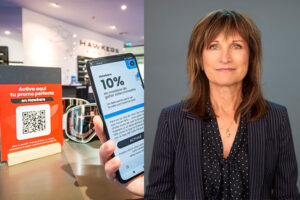PropTech Column by Peter Tonstadt
However, it is important to remember that during such cycles, the risk of complacency and failure to innovate may be even greater.
Where Does That Put Digital in This Landscape?
Digitalization is often touted as the solution for both growth and cost efficiency, but the introduction of new technologies and services also involves a certain level of investment. I am sure that everyone reading this has experienced a situation in the past in which projects that were obviously financially beneficial in the long term were cancelled or postponed due to short-term financial constraints. Generally speaking, we are currently seeing the retail real estate market split into two. One half is holding back on anything new and cutting costs as much as they can, including cutting back on staff and marketing activities. The other half is ramping up investments in digital, as they see it as part of the solution – not as something they can ignore or postpone.
The reality is that as consumers become more financially strapped and more price-sensitive, they will increasingly gravitate towards online shopping, where pricing is a key driver of engagement. That brings us back to the fundamental question: How can shopping centers evolve and become part of the e-commerce economy? The answer is simple, although getting there requires substantial effort: Shopping centers also need to become digital marketplaces. We are currently involved in 14 shopping center marketplace projects, and the big question revolves around when others will follow in large numbers. We are convinced that will happen, but industry success depends on many getting on board sooner rather than later, as that is the way to get retailers on board in large numbers and change consumer behavior – creating increased efficiency and value for everyone in the industry.
When it comes to operational excellence, digital should always be part of the plan. From an operations perspective, digital is all about creating cost efficiency and increased customer satisfaction. Consolidating and automating processes frees up resources for other tasks. One obvious perspective is the one that is taken with respect to the tenants. How many means of communication do you engage in with your tenants over the course of a year? How much is done manually, on a one-to-one basis?
“The reality is that consumers will increasingly gravitate towards online shopping, where pricing is a key driver of engagement.”
Our mantra at Placewise has always been “start with the customer and tenant experience” – make it (SPREE) simple, personal, rewarding, enjoyable, and engaging. The data layer comes next: Make sure you can consolidate data from both the shopper and tenant perspectives on the same platform. That gives you the opportunity to add services and offerings across your entire business and to all of your stakeholders, regardless of what the ultimate objective is. For example, if you can gather content from retailers directly via a tenant interface, and that content flows into a data layer that is also connected to shoppers, for instance, via kiosks, a loyalty app, and the center website. As a result, consumers can be exposed to relevant content without the need for human interaction. The same logic applies to topics such as sales and maintenance reports.
We are currently engaged in a very interesting discussion with one of our clients. They are opening a new mixed-use property in 18 months. The discussion centers around how we can rethink the digital use of this property from the very beginning, when there are no limitations. The idea is to position the property as a “digital location”. That means all operational processes will be supported by a digital tool. In addition, all users of the property will have a digital offering tailored to their needs, depending on whether they live, work, or just visit the property. With respect to the tenants, a so-called “digital operations agreement” is to be signed as part of the leasing terms. The agreement will commit the property to a certain level of digital offering, but it will also obligate tenants to contribute to and use the digital tools. The full potential of the digital offering can only be achieved if all tenants agree to use the same tools.
Perhaps this project will set a new standard for operational excellence in the industry.

is the CEO of Placewise Group and author of the ACROSS PropTech Column






